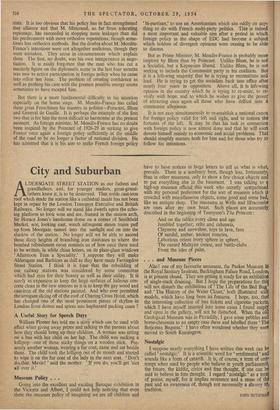City and Suburban
ALDERSGATE STREET STATION as our fathers and grandfathers, and, for younger readers, great-grand- fathers knew it, is to be destroyed. That noble cast-iron roof which made the station like a cathedral inside has not been kept in repair by the London Transport Executive and British Railways. No longer will we stand like dwarfs upon the echo- ing platform to look west and see, framed in the station arch, Sir Horace Jones's handsome dome on a corner of Smithfield Market, nor, looking east, watch infrequent steam trains puff up from Moorgate tunnel into the sunlight and on into the shadow of the station. No longer will we be able to ascend those dizzy heights of branching iron staircases to where the bombed refreshment room reminds us of how once there used to be written, in white china letters, on its plate-glass windows ' Afternoon Teas a Speciality.' I suppose they will make Aldersgate and Barbican as dull as they have made Farringdon Street Station. I think it is time that the rebuilding of our railway stations was considered by some committee which had eyes for their beauty as well as their utility. It is surely as expensive to keep the large surfaces of hideous con- crete clean in the new stations as it is to keep the gay wood and cast-iron of the old stations painted. And who ever permitted the arrogant slicing off of the roof of Charing Cross Hotel, which has changed one of the most prominent pieces of skyline in London from domes and spires into haphazard packing cases ?
A Useful Story for Speech Days William Plomer has told me a story which can be used with effect when giving away prizes and talking to the parents about how they should bring up their children. A woman was sitting on a bus with her child on her lap. The child was sucking a lollipop—one of those sticky things on a wooden stick. Pre- sently another woman, wearing a fur coat, came and sat beside them. The child took the lollipop out of its mouth and started to wipe it on the fur coat of the lady in the next seat. ' Don't dot that, Mavis! ' said the mother. ' If you do, you'll get 'airs all over it.' have to have notices in large letters to tell us what is what, prevails. There is a tendency here, though less, fortunately, than in other museums, only to show a few choice objects and to put everything else in the basement. I was talking to high-up museum official this week who secretly sympathised with my personal preference for the sort of museum which iS crowded with miscellaneous objects, some good and some bad, like an antique shop. The museums at Wells and Ilfracombe are ones after my own heart. Such places are accurately, described in the beginning of Tennyson's The Princess: And on the tables every clime and age Jumbled together; celts and calumets. Claymore and snowshoe, toys in lava, fans Of sandal, amber, ancient rosaries, Laborious orient ivory sphere in sphere, The cursed Malayan crease, and battle-clubs From the isles of palm.
. . . and Museum Pieces Alas! one of my favourite museums, the Parkes Museum iQ the Royal Sanitary Institute, Buckingham Palace Road, London, is at present closed. They are getting it ready for an exhibitiott of single-stack draining. But I hope the preparations for thij will not disturb the exhibitions of The Life of the Bed Bug and The History of the Water Closet,' both illustrated with models, which have long been its features. I hope, too, that the interesting collection of bus tickets and cigarette packets which I have myself inserted into some cases I found emp and open in the gallery, will not be disturbed. When the of Geological Museum was in Piccadilly, I gave some pebbles an horse-chestnuts to an empty case there and labelled them The Betjeman Bequest.' I have often wondered whether they were moved to South Kensington.
Nostalgic


































 Previous page
Previous page